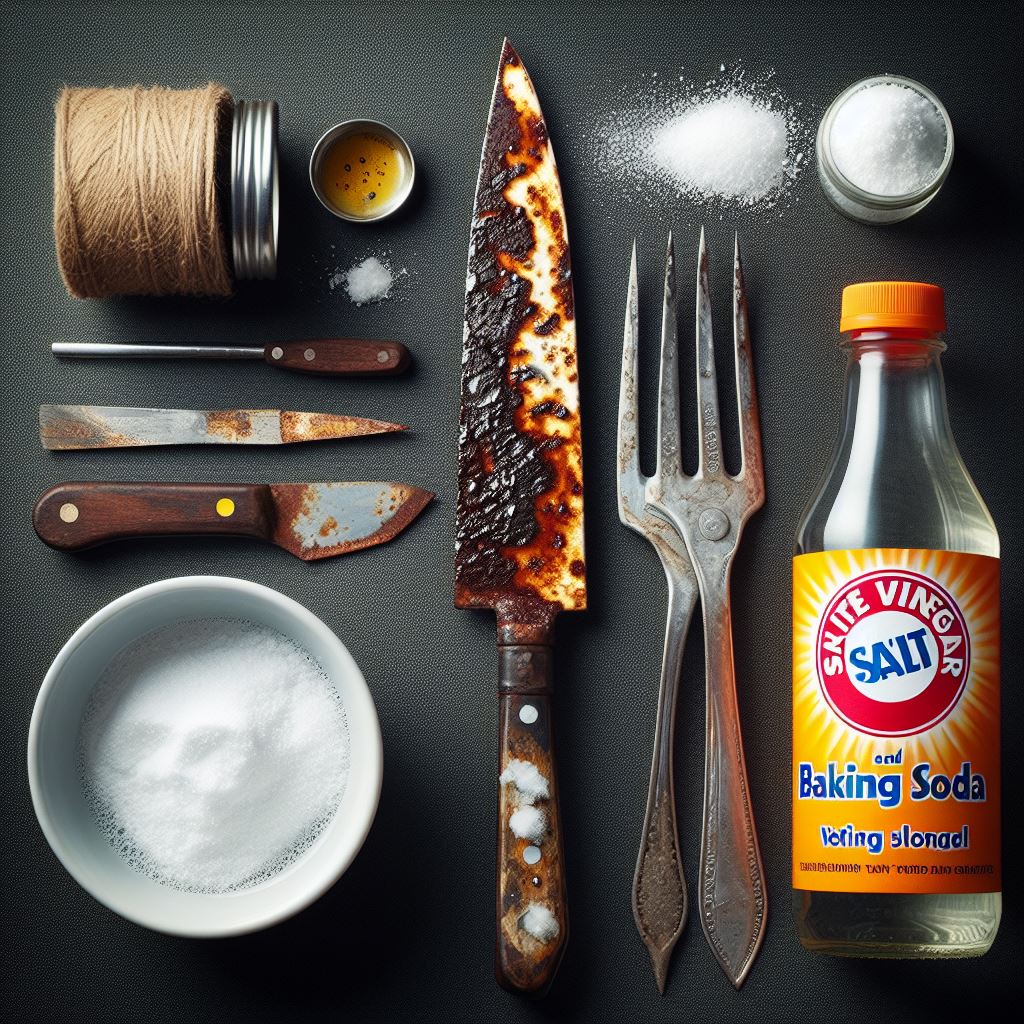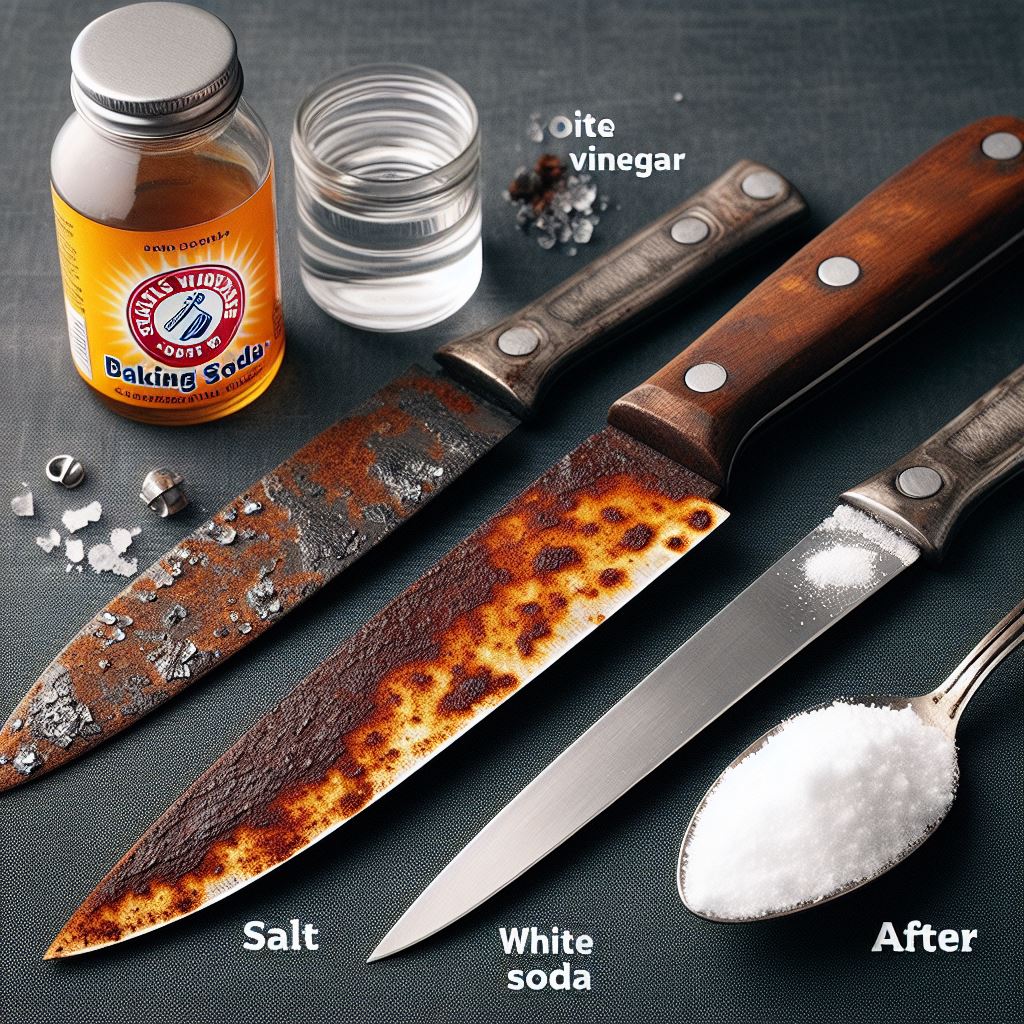To get the rust off the knife, you can use a mixture of baking soda and water or vinegar. Apply the paste, scrub gently, then rinse and dry the knife thoroughly.
Discovering rust on your favorite kitchen knife can be disheartening. The key to successfully restoring its shine lies in prompt and proper care. Rust is not only unsightly but can also affect the performance of your knife. In this article, we’ll provide you with easy and effective ways how to get rust off knife.

Step-by-step Tips on How to Get Rust off Knife
Discover knives gleaming like new with these tried-and-true home solutions. Rust, the reddish-brown flake from metal’s battle with moisture and oxygen, doesn’t have to signal the end of your favorite blade. Bypass the chemical rust removers and dive into the treasure trove of your pantry to restore your knives’ shine. With ingredients like white vinegar, baking soda, and lemon juice, you’re only a few steps away from rust-free cutlery. Let’s explore these easy, safe, and cost-effective techniques that make rust removal a breeze.
Step 1. Using White Vinegar For Soaking And Scrubbing
White vinegar, with its acetic acid content, works wonders on rust. This pantry staple provides a natural and affordable solution for treating rusted knives. Follow these simple steps:
- Submerge the rusty knife entirely in a glass filled with white vinegar.
- Soak the knife for at least five minutes or overnight for heavy rust.
- Remove and gently scrub the rust off with a ball of aluminum foil or a soft brush.
- Rinse thoroughly with water and dry immediately to prevent further rusting.
Step 2. Creating A Baking Soda Paste For Gentle Abrasion
Baking soda – the gentle giant of rust removal. It’s non-toxic, easily available, and ideal for knives with a bit of rust. Here’s your guide:
- Mix baking soda with water to create a thick paste.
- Apply the paste evenly across the rusted areas of the knife.
- Let it sit for a couple of hours; patience rewards you here.
- Scrub the paste off with a toothbrush or soft-bristled brush.
- Rinse well and towel dry your knife.
Step 3. Lemon Juice And Salt For Organic Acidic Treatment
Lemon juice, when combined with salt, forms a natural acidic scrub. Its citric acid eats away the rust. To wield this zesty power:
- Sprinkle a generous amount of salt over the rust spots.
- Squeeze lemon juice over the salt to soak the rust.
- Let it sit for about two hours; longer for stubborn rust.
- Use the lemon rind or a soft brush to scrub the mixture.
- Thoroughly rinse the knife with water and dry it off.
Step 4. Potato And Dish Soap: A Surprising Rust Remover
Bet you didn’t know the humble potato could double as a rust treatment. The oxalic acid in potatoes dissolves rust. Combine it with dish soap, and you’re in for a clean surprise:
- Stick the knife into a potato and let it sit for several hours.
- Remove the knife, then scrub with a sponge soaked in dish soap.
- Rinse well and immediately pat dry.
Chemical Solutions And Commercial Products
Among the various methods to banish rust from your beloved knives, Chemical Solutions and Commercial Products stand out for their efficiency and ease of use. Whether it’s for kitchen cutlery, a cherished pocket knife, or a valuable collector’s item, the approach to ridding your metal companions of oxidation is critical. With the myriad of options available, understanding when and how to deploy these potent solutions can save not only your knives but also your time and effort.
When To Opt For Chemical Rust Removers
Chemical rust removers are a potent ally in the war against corrosion. If you encounter stubborn or extensive rust, which manual scrubbing can’t tackle, it’s time to consider these specialized formulas. Ideal scenarios include:
- Deep-seated rust: that’s ingrained in the knife’s surface.
- Delicate knives: where abrasive methods might cause damage.
- Time constraints: as chemicals typically work faster than manual methods.
How To Use Commercial Rust Removal Products Safely
While commercial rust removal products offer a hassle-free solution, their proper application is paramount for user safety and maintaining the integrity of the knife. Follow these steps:
- Read the product instructions carefully.
- Don protective gear, including gloves and goggles.
- Apply the rust remover to the affected area, avoiding contact with the knife’s handle or any non-metal parts.
- Allow the remover to sit for the duration specified by the product’s guidelines.
- After the treatment, rinse the knife thoroughly with water to wash away chemical residues.
- Dry the knife immediately to prevent new rust from forming.
The Role Of Lubricants And Protectants Post-rust Removal
Post-rust removal, the application of lubricants and protectants is crucial for preserving the longevity and functionality of the knife. These products serve to:
| Lubricants/Protectants | Benefits |
|---|---|
| Lubricants | Provide a smooth action for folding knives and safeguard against future rust. |
| Protectants | Create a barrier against moisture and corrosion, keeping your knife in top condition. |
To apply, ensure the knife is dry and clean. Use a soft cloth to evenly distribute the lubricant or protectant on the blade and any moving parts, if applicable. Finally, wipe off excess product to prevent grime buildup, preserving the pristine condition of your knife.
Mechanical Methods For Stubborn Rust
Tackling stubborn rust on your knife not only requires patience but the right mechanical methods as well. These techniques are hands-on and can restore a blade to its former glory, especially if you’re dealing with severe or resistant rust. From scouring to utilizing the power of electricity or high-speed tools, each method offers a unique approach to conquering corrosion. Let’s dive into some of the most effective mechanical methods to remove that unwelcome rust.

Method 1. The Use Of Steel Wool And Sandpaper For Scouring
Steel wool and sandpaper are readily accessible tools that are perfect for manually removing rust from knives. The process is straightforward yet effective:
- Select the right grade: Start with a coarser grit to tackle the heavy rust and gradually move to a finer grit for a polished finish.
- Scrub gently: Apply consistent, light pressure to avoid scratching the knife’s surface excessively.
- Methodical approach: Work in one direction to ensure an even scouring pattern on the blade.
Remember that patience is key. Frequent checks on progress and gentle handling will ensure that the knife is not over-scoured and retains its integrity.
Method 2. Electrolysis: A Diy Method For Dedicated Enthusiasts
For those who enjoy a bit of DIY, electrolysis is an intriguing method to deal with rust. By using an electrical current, you can reverse the oxidation process and effectively lift rust off the blade. Here’s a simplified breakdown:
- Gather materials: You’ll need a sacrificial electrode, a battery charger or power supply, and a solution of water and washing soda.
- Safety first: Wear protective gear, including gloves and goggles, to ensure safety.
- Set up: Submerge the knife and the electrode into the solution, and connect the charger.
- Monitor: Keep an eye on the process, as times can vary based on rust severity and setup efficiency.
Electrolysis is a powerful rust removal option for enthusiasts who appreciate a hands-on approach to tool maintenance.
The Pros And Cons Of Using A Dremel Or Other Power Tools
Power tools like a Dremel can make quick work of rust removal, but they require a deft touch. When correctly used, these tools can:
| Pros | Cons |
|---|---|
| Save time on rust removal Effortlessly remove large rust patches Offer precision with various attachments | Pose a risk of scratching or gouging Require skill to avoid damage Generate heat that may affect tempering |
It’s essential to practice on a less important piece of metal before working on a favored knife. Mastery of the tool ensures a rust-free blade without damage.
Preventative Measures And Long-term Care
Understanding Preventative Measures and Long-term Care for your knives ensures they remain in pristine condition, free from the bane of rust. Not only will these steps maintain the sharpness and luster of your knife, but they will also extend its lifespan and performance. By embracing regular maintenance, proper storage practices, and knowing when to seek professional care, you can keep any form of corrosion at bay.
Regular Maintenance To Prevent Rust
Regular cleaning and drying are fundamental to rust prevention. Each use should be followed by washing the knife with mild soapy water, thoroughly rinsing, and immediately drying with a soft cloth. To enhance protection, consider applying a light coat of food-safe mineral oil on the blade. This creates a barrier against moisture, which is the primary culprit in rust formation.
- Wash promptly after use
- Rinse with clean water
- Dry immediately to prevent moisture
- Oil the blade regularly with a food-safe mineral oil
Best Practices For Storing Knives
Storage plays a crucial role in the care of your knives. Avoid damp or confined spaces where moisture can accumulate, leading to rust. Instead, use a knife block, magnetic strip, or sheath to prevent blades from coming into contact with one another, which can cause scratches and corrosion. Ensure these storage solutions are clean and dry before inserting knives.
| Storage Method | Benefits |
|---|---|
| Knife Block | Keeps knives separated and protected |
| Magnetic Strip | Provides easy access and displays knives |
| Protective Sheath | Guards the blade when stored in drawers |
When To Seek Professional Knife Sharpening And Care
Professional knife care is recommended when a blade becomes dull, chipped, or develops rust that cannot be removed through home methods. Expert sharpening ensures that the correct angle and techniques are used, preserving the knife’s edge and integrity. Pros can also perform thorough cleaning and apply specialized treatments to guard against future rust, optimizing your knife’s performance.
Signs indicating the need for professional care include:
- Difficulty with cutting tasks
- Visible rust or discoloration
- Chips or nicks in the blade
- Uneven edges or significant dullness
Seeking professional attention at the right time can save your knife from permanent damage and ensure that your culinary tools continue aiding you effectively in the kitchen.

Last Words To Follow
Banishing rust from your knives maintains both their performance and appearance. Following the methods outlined here ensures your blades stay pristine and sharp. Regular care prevents future rust, keeping your knives in top condition for all your culinary adventures. Don’t forget, a little maintenance goes a long way!







